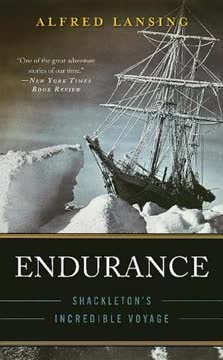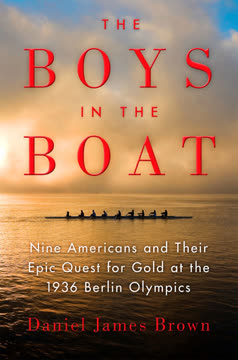Key Takeaways
1. The Allure and Peril of the American West Beckoned
We look out upon them and are astonished to see such careless ease and joyousness manifested in the countenances of almost all—the old, the young, the strong and feeble—the sprightly boy and the romping girl. . . .
Dreams of a better life. The American West, particularly California, was portrayed as a land of boundless opportunity, fertile soil, and a disease-free climate, drawing families from the Midwest seeking escape from economic hardship and illness. Lansford Hastings's Emigrants' Guide fueled this desire, promising a paradise for those willing to brave the journey.
Reality vs. Perception:
- Fertile land and mild climate contrasted with the harsh realities of the journey.
- The promise of wealth clashed with the potential for starvation and death.
- The dream of a new beginning was juxtaposed with the loss of home and community.
Sarah's Hopeful Start: Young Sarah Graves Fosdick, newly married, embodied this optimism, envisioning a home and a future with her family in this promised land, unaware of the trials that lay ahead. This initial hope, however, would soon be tested by the brutal realities of the trail.
2. Manifest Destiny Fueled Expansion, Disregarding Consequences
Unless you pass over the mountains early in the fall, you are very liable to be detained by impassable mountains of snow until the next spring, or perhaps forever.
Expansionist Ideology: The concept of Manifest Destiny, the belief that Americans were destined to expand across the continent, drove westward migration, often at the expense of Native American populations and Mexican territories. This ideology justified the displacement and subjugation of others in the pursuit of land and resources.
Hastings's Role:
- Hastings promoted California as a land ripe for American settlement.
- He downplayed the rights of Mexican Californians and Native Americans.
- His shortcut promised a faster route but led to unforeseen dangers.
Polk's War: President James K. Polk's declaration of war against Mexico further fueled the desire for expansion, with California as the ultimate prize, setting the stage for conflict and upheaval in the region. The pursuit of this "destiny" blinded many to the potential for tragedy.
3. The Illusion of Shortcuts Can Lead to Disaster
The most direct route, for the California emigrants, would be to leave the Oregon route, about two hundred miles east from Fort Hall; thence bearing southwest, to the Salt Lake; and thence continuing down to the bay of St. Francisco, by the route just described.
The Lure of Expediency: Lansford Hastings's shortcut, promoted in his Emigrants' Guide, promised to save hundreds of miles, tempting emigrants with the prospect of a quicker journey. This shortcut, however, was based on Hastings's limited knowledge and disregard for the true challenges of the terrain.
Consequences of the Hastings Cutoff:
- Unfamiliar and treacherous terrain
- Increased travel time due to difficult conditions
- Depletion of resources and exhaustion of livestock
The Donner Party's Fatal Decision: The Donner Party's decision to take the Hastings Cutoff, despite warnings, proved to be a critical turning point, leading them into a deadly trap and highlighting the dangers of prioritizing speed over safety. The allure of a shortcut ultimately led to their demise.
4. Survival Demands Brutal Choices and Erodes Humanity
And nothing can we call our own but death / And that small model of the barren earth / Which serves as paste and cover for our bones.
Descent into Desperation: As the Donner Party became trapped in the Sierra Nevada, dwindling supplies and the threat of starvation forced them to make increasingly difficult choices. The initial focus on cooperation and community gradually eroded as the struggle for survival intensified.
Moral Boundaries Tested:
- Theft and hoarding of resources became more common.
- Arguments and divisions arose within the group.
- The decision to resort to cannibalism marked a profound moral turning point.
The Erosion of Humanity: The extreme conditions stripped away the veneer of civilization, revealing the raw instincts and primal drives that govern human behavior in the face of death. The descent into cannibalism, while born of necessity, left an indelible stain on the survivors' souls.
5. Women Displayed Resilience Amidst Unimaginable Hardship
They were not delicate hothouse plants.
Strength in Adversity: Despite the patriarchal society of the 1840s, women like Sarah Graves, Elizabeth Donner, and Margret Reed demonstrated remarkable resilience, resourcefulness, and courage in the face of unimaginable hardship. They took on traditionally male roles, such as driving wagons and hunting, while also maintaining their roles as caregivers and nurturers.
Women's Roles:
- Providing emotional support and maintaining morale
- Rationing food and managing dwindling supplies
- Caring for the sick and injured
- Making difficult decisions to ensure their families' survival
Sarah's Journey: Sarah's transformation from a young bride to a resilient survivor exemplifies the strength and adaptability of women in the face of extreme adversity. She faced the loss of her husband and father, yet continued to fight for the survival of her siblings.
6. Cannibalism: A Taboo Born of Desperation
The meager by the meager were devoured.
The Ultimate Taboo: The decision to resort to cannibalism represents the most extreme and horrifying aspect of the Donner Party tragedy, a testament to the desperation and unimaginable suffering they endured. This act, deeply ingrained in human consciousness as a taboo, was born of starvation and the will to survive.
Moral and Psychological Toll:
- The act of consuming human flesh left lasting psychological scars on the survivors.
- Guilt, shame, and trauma haunted them for the rest of their lives.
- The decision to cannibalize was often framed as a sacrifice, a means of ensuring the survival of loved ones.
The Breaking Point: The decision to cross this moral boundary marked a profound shift in the Donner Party's story, forever altering their perception of themselves and their place in the world. It was a choice made under duress, a testament to the limits of human endurance.
7. Trauma Leaves Indelible Scars on Body and Soul
To look upon these sad monuments harrows up every sympathy of the heart & soul, & you almost hold your breath to listen for some mournful sound from these blackened, dismal, funeral piles, telling you of their many sufferings & calling on you for bread, bread.
Lasting Psychological Effects: The survivors of the Donner Party, including Sarah Graves, carried the trauma of their experiences with them for the rest of their lives. Post-traumatic stress disorder (PTSD), though not yet defined, manifested in various ways, including nightmares, flashbacks, emotional numbness, and difficulty forming relationships.
Physical and Emotional Toll:
- Malnutrition and exposure left lasting physical damage.
- The psychological burden of cannibalism and loss weighed heavily on their minds.
- The struggle to reintegrate into society was often difficult and isolating.
Sarah's Later Life: Sarah's subsequent marriages and moves suggest a search for stability and peace, but the scars of the Sierra Nevada likely never fully healed. The trauma she endured shaped her worldview and influenced her decisions for the rest of her life.
8. The Fragility of Hope in the Face of Overwhelming Odds
HOPE, the bright, beaming star is ascendant in their sky, alluring them on. . . .
The Power of Hope: Despite the mounting hardships and tragedies, the Donner Party clung to hope as a means of survival. The belief that they would eventually reach California and build a better life sustained them through unimaginable suffering.
The Erosion of Hope:
- The Hastings Cutoff shattered the illusion of a quick and easy journey.
- The loss of livestock and dwindling supplies tested their resolve.
- The deaths of loved ones and the descent into cannibalism threatened to extinguish all hope.
Sarah's Tenacity: Sarah's continued efforts to care for her siblings and find a new life after the disaster demonstrate the enduring power of hope, even in the face of overwhelming odds. She embodies the human capacity to find meaning and purpose in the aftermath of tragedy.
9. The Indifference of Nature to Human Suffering
And left her to the indifferent stars above.
Nature's Impartiality: The Donner Party's story underscores the indifference of nature to human suffering. The Sierra Nevada, with its beauty and its brutality, offered no solace or reprieve to the trapped emigrants.
The Power of the Elements:
- Blizzards, starvation, and disease ravaged the Donner Party.
- The landscape, while stunning, offered no easy path to survival.
- The emigrants were forced to confront their own vulnerability in the face of nature's power.
A Stark Reminder: The Donner Party's tragedy serves as a stark reminder of the limits of human control and the humbling force of the natural world. It highlights the importance of respecting nature's power and preparing for the unexpected.
Last updated:
FAQ
1. What is The Indifferent Stars Above by Daniel James Brown about?
- Harrowing Donner Party saga: The book recounts the tragic journey of the Donner Party, a group of American pioneers trapped by snow in the Sierra Nevada during the winter of 1846–47.
- Focus on Sarah Graves: It centers on the experiences of Sarah Graves Fosdick, a young bride, and her family as they struggle to survive extreme conditions.
- Rich historical context: The narrative provides detailed day-by-day accounts, exploring the social, cultural, and environmental challenges of the mid-19th-century American West.
- Themes of endurance: The story highlights human resilience, moral dilemmas, and the psychological impact of trauma in the face of overwhelming adversity.
2. Why should I read The Indifferent Stars Above by Daniel James Brown?
- Deeply researched history: The book offers a vivid, comprehensive portrayal of one of America’s most infamous pioneer disasters, revealing lesser-known personal stories and historical details.
- Insight into survival psychology: Readers gain valuable understanding of how starvation, hypothermia, and trauma affect human behavior and decision-making under extreme stress.
- Broader cultural context: The narrative enriches the story with insights into 19th-century frontier life, family roles, and evolving American traditions.
- Compassionate storytelling: Daniel James Brown brings empathy and nuance to the individuals involved, moving beyond stereotypes to show their complexity and humanity.
3. Who was Sarah Graves, and why is she central in The Indifferent Stars Above by Daniel James Brown?
- Ordinary yet remarkable emigrant: Sarah Graves was a 21-year-old woman who left Illinois with her family and fiancé, Jay Fosdick, to seek a new life in California.
- Limited personal records: With few direct writings from Sarah, the author reconstructs her experience using eyewitness accounts and expert testimony.
- Symbol of her generation: Sarah represents the courage, hope, and complexity of the 1840s emigrant generation, facing extraordinary hardship.
- Emotional core of the story: Her journey personalizes the broader tragedy, making the historical events more relatable and poignant.
4. What was the Donner Party, and what tragedy did they face according to The Indifferent Stars Above?
- Westward emigrant group: The Donner Party was a group of families and individuals traveling to California in 1846, seeking new opportunities.
- Trapped by early snow: They became stranded in the Sierra Nevada by heavy snowfall, unable to proceed or retreat.
- Struggle for survival: The group endured starvation, freezing temperatures, and internal conflicts, leading to deaths and desperate measures, including cannibalism.
- Detailed narrative: The book explores the decisions, hardships, and psychological toll of their ordeal in depth.
5. What were the main challenges and living conditions faced by the Donner Party in The Indifferent Stars Above?
- Harsh environments: The emigrants faced mud, dust, mosquitoes, snow, freezing temperatures, and scarce food and water across plains, deserts, and mountains.
- Health and hygiene issues: Limited bathing, lice infestations, poor nutrition, and injuries were common, with many suffering from malnutrition and hypothermia.
- Psychological strain: Fear, despair, internal conflicts, and the trauma of death and starvation weighed heavily on the group.
- Shelter and resource scarcity: Makeshift cabins and shanties offered little protection, and food supplies dwindled rapidly.
6. How did Lansford Hastings’s advice and route impact the Donner Party’s fate in The Indifferent Stars Above?
- Promotion of a shortcut: Hastings published The Emigrants’ Guide, advocating a shortcut through the Wasatch Mountains, which he had not personally tested with wagons.
- Misleading and dangerous: The route was far more difficult than advertised, causing significant delays and adding about a month to the journey.
- Financial motives: Hastings and Fort Bridger proprietors had financial incentives to promote the route, withholding warnings about its dangers.
- Direct contribution to disaster: The delay from following Hastings’s advice was a key factor in the party being trapped by early snow.
7. How did the Donner Party prepare for their journey, and what supplies did they carry as described in The Indifferent Stars Above?
- Careful provisioning: Emigrants packed flour, bacon, coffee, sugar, salt, dried fruits, hardtack, and cooking utensils, balancing weight and necessity.
- Tools and weapons: They brought axes, shovels, guns (flintlock and percussion), ammunition, and wagon repair tools for survival and defense.
- Packing challenges: Overloading wagons risked exhausting oxen, while underpacking risked starvation or exposure, making supply decisions critical.
- Constant adjustments: Supplies were often lost, stolen, or consumed faster than expected, forcing difficult choices along the way.
8. What role did women play in the Donner Party’s survival according to The Indifferent Stars Above by Daniel James Brown?
- Emotional and physical strength: Women like Sarah, Mary Ann, and Harriet Pike took initiative in leading, gathering wood, making fires, and caring for children and the sick.
- Moral and psychological burden: They bore immense emotional weight, especially when loved ones’ bodies were consumed for survival.
- Resource management: Women managed scarce food, prepared meager meals, and made agonizing decisions about who could travel or be left behind.
- Central to endurance: Their constancy and courage were crucial in sustaining group morale and survival.
9. How did survival cannibalism come about in The Indifferent Stars Above, and what was its impact?
- Last resort for survival: After days without food and suffering from hypothermia, the snowshoe party began to consume the flesh of those who had died.
- Psychological trauma: The act caused immense guilt and shame, especially for those who had to draw lots or witness the deaths of companions.
- Historical context: The book situates this within a broader history of survival cannibalism, emphasizing that most people choose death over cannibalism unless utterly desperate.
- Lifelong consequences: Survivors bore lifelong emotional scars and social stigma from the experience.
10. What were the key rescue efforts described in The Indifferent Stars Above by Daniel James Brown?
- First Relief party: Led by Reason P. Tucker, this group brought limited supplies and evacuated some survivors from the lake camp in February 1847.
- Second Relief party: Led by James Reed and William McCutchen, this better-provisioned group rescued more people, including Sarah and Mary Ann.
- Subsequent reliefs: Third and Fourth Relief parties continued rescue and salvage operations, recovering valuables and the last survivors.
- Naval involvement: A U.S. naval officer, Selim Woodworth, led a relief effort but faced reluctance from his men due to the dangers involved.
11. How does The Indifferent Stars Above by Daniel James Brown portray the psychological effects of trauma and starvation on survivors?
- Post-Traumatic Stress Disorder: Many survivors likely suffered from PTSD, with symptoms like flashbacks, emotional numbness, and intrusive thoughts.
- Guilt and shame: Those who resorted to cannibalism experienced profound guilt and shame, affecting their emotional well-being for life.
- Physical brain changes: The book discusses how trauma can alter brain structures, leading to emotional dysregulation and increased risk of depression.
- Lasting emotional scars: Survivors, especially women and children, often struggled to discuss their experiences and carried the trauma for decades.
12. What is the significance of the title and epigraph of The Indifferent Stars Above by Daniel James Brown?
- Epigraph from W. B. Yeats: The poem “A Dream of Death” evokes the image of a solitary grave “left to the indifferent stars above,” symbolizing the harsh, uncaring natural world.
- Theme of indifference: The title reflects the emigrants’ struggle against an indifferent universe—nature’s vastness and cruelty amid human suffering.
- Human resilience: Despite nature’s indifference, the book highlights the courage, complexity, and humanity of those who faced overwhelming odds.
- Philosophical reflection: The title invites readers to consider the meaning of suffering and endurance in a world that offers no guarantees of justice or mercy.
Review Summary
The Indifferent Stars Above recounts the harrowing journey of the Donner Party, focusing on Sarah Graves. Readers praise Brown's meticulous research, vivid storytelling, and ability to humanize the participants. The book offers a comprehensive look at 1840s pioneer life and the psychological impact of extreme circumstances. While some found it difficult to follow due to numerous characters, most applaud Brown's balanced approach to the cannibalism aspect. Many readers express emotional investment in the story, finding it both heartbreaking and fascinating.
Similar Books








Download PDF
Download EPUB
.epub digital book format is ideal for reading ebooks on phones, tablets, and e-readers.






